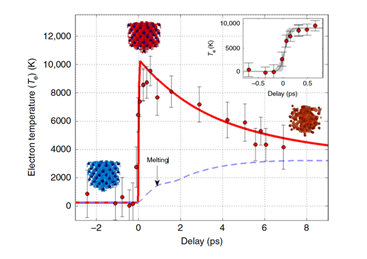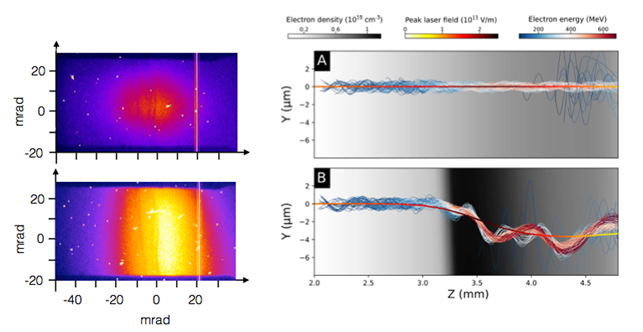Relativistic X-ray Sources
Our main goal is to develop novel femtosecond x-ray sources. To this end, we explore the x-ray radiation mechanisms in relativistic laser-plasma interaction.
Reference : S. Corde et al., Reviews of Modern Physics, 85, 1 (2013) – https://link.aps.org/doi/10.1103/RevModPhys.85.1.
In 2003, we demonstrated that non-linear Thomson scattering can reach the x-ray range. It is produced by free electrons oscillating in an intense laser field.
Reference : K . Ta Phuoc et al., Phys. Rev. Lett. 91, 19, 195001 (2003) – https://link.aps.org/doi/10.1103/PhysRevLett.91.195001.
In 2004, we demonstrated the Laser-based Betatron source, delivering for the first time femtosecond x-ray beams in the keV energy range. It is produced by electrons accelerated and wiggled in a laser Wakefield.
Reference : A. Rousse et al., Phys. Rev. Lett. 93, 13, 135005 (2004) – https://link.aps.org/doi/10.1103/PhysRevLett.93.135005.
In 2006, the femtosecond nature of the Betatron source was experimentally demonstrated. In addition, we showed the potential of this novel source for the studies of ultra-fast structural dynamic at the femtosecond time scale.
Reference : K .Ta Phuoc et al., Physics of Plasmas 14, 080701(2007) – https://aip.scitation.org/doi/10.1063/1.2754624.
In 2012, first high energy x-ray beams (100 keV range) were produced using a simple all-optical scheme based on Thomson backscattering. The radiation is produced by colliding relativistic electrons from a laser-plasma accelerator and an intense femtosecond laser pulse.
Reference : K. Ta Phuoc et al. Nature Photonics. 6,308-311(2012) – https://www.nature.com/articles/nphoton.2012.82.
Recent progresses:
2017 – Stabilisation of the Betatron x-ray source :

The betatron source, which essentially reproduces the principle of a synchrotron at the millimeter scale, provides bright radiation with femtosecond duration and high spatial coherence. However, despite its unique features, the usability of the betatron source has been constrained by its poor control and stability. In 2017, we demonstrated the reliable production of X-ray beams with tunable polarization. Using ionization-induced injection in a gas mixture, the orbits of the relativistic electrons emitting the radiation are reproducible and controlled. We observe that both the signal and beam profile fluctuations are significantly reduced and that the beam pointing varies by less than a tenth of the beam divergence. The polarization ratio reaches 80%, and the polarization axis can easily be rotated. We anticipate a broad impact of the source, as its unprecedented performance opens the way for new applications.
Reference : A. Doepp et al., Light Science and Applications 6, e17086 (2017) –https://www.nature.com/articles/lsa201786.pdf?draft=marketing.

2018 – Femtosecond x-ray absorption spectroscopy :
In 2018 we gathered a team of scientists with complementary expertise from LOA, CEA and CELIA and we successfully performed the first femtosecond XANES (X-ray Absorption Near-Edge Spectroscopy) experiment.
Time evolution of the electron temperature of a 80 nm Copper sample heated with a 30 fs laser pulse at 1J/cm2 fluence. The data deduced from time-resolved XAS measurements (full circles) are compared with the two temperature hydrodynamic calculation (plain line). The calculated ion temperature is also plotted (dashed line).
We measured the femtosecond dynamic of the Copper L-edge brought to Warm Dense Matter (WDM) conditions. A clear spectral feature (pre-edge) was observed as a result of the ultrafast electron temperature increase. The temporal resolution was evaluated to 75 ± 25 fs, mainly limited by the geometry of such proof-of-principle experiment. This first experiment demonstrates the great potential of the Betatron source and open unprecedented possibilities for femtosecond X-ray absorption. Our project aims at developing this novel class of experiments.
B. Mathieu et al., Nature Communications 9; 3276 (2018) – https://www.nature.com/articles/s41467-018-05791-4.
2019 – Plasma tailoring :
When produced with Terawatt class femtosecond lasers, the energy and flux of a Betatron source is not sufficient to compete with synchrotron sources, thus limiting their dissemination and its possible applications.
In 2019 we demonstrated a simple method to enhance the energy and the flux of Betatron sources without increasing the laser energy. The orbits of the relativistic electrons emitting the radiation were controlled using density tailored plasmas so that the energetic efficiency of the Betatron source is increased by about one order of magnitude.
Reference : M. Kozlova et al., Phys. Rev. X 10, 011061 (2020) – https://link.aps.org/doi/10.1103/PhysRevX.10.011061.



